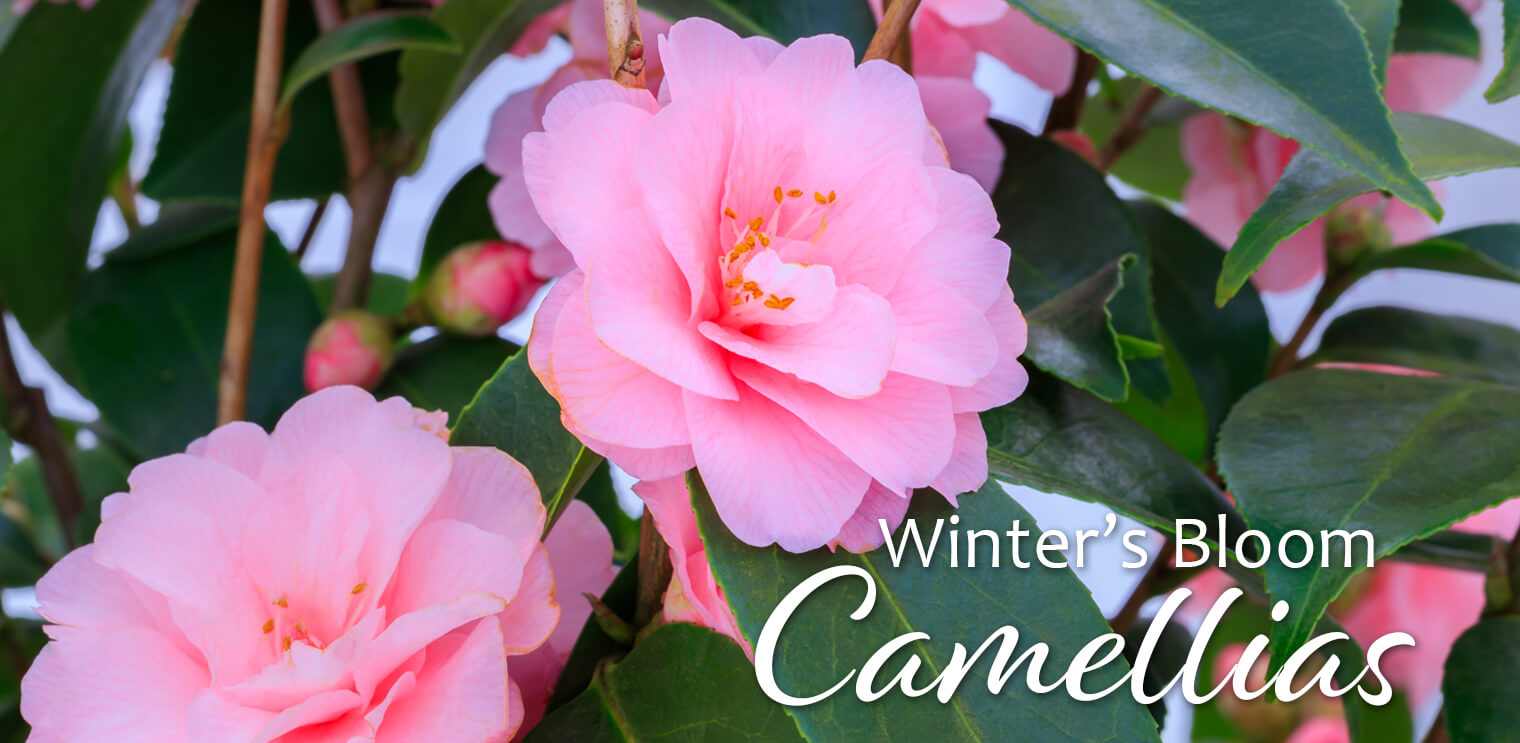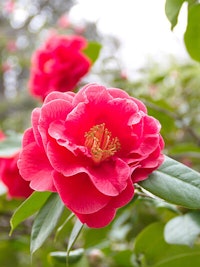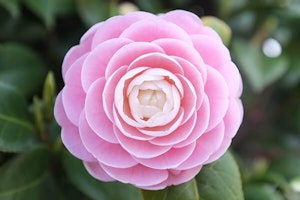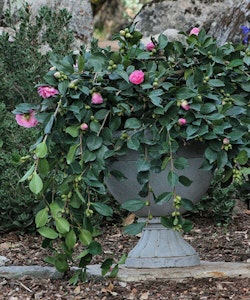 Back to the Be Inspired Blog
Back to the Be Inspired Blog

The Benefits of Planting Camellias in Your Garden
When you’re spending time in your garden and deciding how you want to up your planting game, why not consider the beautiful camellia? This attractive wild evergreen shrub originally from China can provide year-round foliage and cool-season flowers. With thousands of different types of camellia, you are sure to find a fantastic addition to your garden.
Planting Camellias to Attract Garden Visitors
Camellias have long bloom seasons and actively bloom during fall and winter, times that are the off-season for many other plants. Camellias are very long-lived, with some living up to 100 years and growing 25 feet long. While deer deem camellias as their least appealing options on the menu, pollinators love them. The Seattle Times explains that Anna Hummingbirds can become seduced by varieties like the Apple Blossom and the Tanya, and butterflies, like the long-tailed skipper butterfly, are attracted to the glossy leaves of the ‘Kanjiro’ camellia. With camellias in your garden, you will always have visitors, whether it be pollinators or your friends.

Why Planting Camellias Holds Special Meaning
While a rose is typically seen as the universal symbol of romance, in Japan, the camellia is highly respected and known as the “Japanese rose.” Planting camellias is also a great way to show China’s representation of the union between two lovers; their varying rich colors can also have different meanings.
As FTD by Design explains, camellias’ layered petals represent the woman and the calyx (the green leafy part of the stem that holds the petals together) represents the man’s support. For many flowers, when their petals fall, the calyx remains intact. However, with the camellia, when the petals fall, the calyx joins as well and gives us the metaphorical representation of eternal love and long-lasting devotion.
Planting Camellias for The Oil: Skin Benefits
If you’re into homegrown and homemade products, then making camellia oil may be just for you! Sunny Zhang’s Youtube video on how to make Camellia oil is a simple process that only requires your seeds, an oil press and an hour. Japanese women have been using camellia oil on their hair and skin as the open secret for their beauty routine since the Heian Period (794-1185 A.D.). It is a fast-absorbing moisturizer and that can repair age spots, stretch marks and other skin damage due to its high oleic acid (omega-9) content. This high oleic acid is light and can absorb easily into your skin. Makeup removal and nail softening are also extra perks to its properties.

Health Benefits from Planting Camellias
In addition to the skin benefits, tea seed extracted from the Camellia Sinensis plant is a popular remedy for those with high blood pressure; Organic Facts.net reports the vast amount of potassium mineral in camellia is beneficial for blood pressure levels. The monounsaturated fats in the oil positively affect hypertension and lower the risk of heart attack and stroke.
Since Oolong tea and black tea are products made from the leaves, buds and stems of the Camellia Sinensis plant, these teas are also linked to reducing the risk of hypertension. However, those taking medication for hypertension should be wary of using this oil because they could be putting themselves at risk for low blood pressure levels.
Camellia oil also contains a variety of minerals (like calcium, phosphorous and potassium) that can improve bone mineral density and thereby decrease the oncoming stages of osteoporosis. Symptoms from osteoarthritis such as a decrease of range of motion and ability can also be minimized as well.

Planting Camellias for The First Time
When selecting camellias for the garden, consider looking at their bloom times and where you want to plant them. For example, depending on the region, the camellia sasanqua typically blooms from mid fall to early winter while the Japanese camellias start blooming in the middle to late winter.
If you’re planting camellias for the first time, consider these six pieces of advice we recommend:
- 1. Zone: Most hardy camellias are found in zones 7-10, although some, such as the Monrovia Ice Angels® series, are hardy to zone 6.
- 2. Soil: Camellias need slightly acidic soil (pH 5.5-6.5), so planting in your garden’s first year is not recommended. Alkaline soil can negatively affect the camellia resulting in yellow leaves.
- 3. Light: In general, camellias grow and bloom better in partial shade with shelter from hot afternoon sun. While most camellias need good light to thrive and to form flower buds, shade is important to protect from the hot mid-day sun; when it hits the flowers, they can become bleached and their buds may begin to shrivel. As the camellias grow larger, their roots can be shaded by their thick canopy of leaves and will eventually be able to accept more sun. In the winter time, this shade helps reduce cold damage for camellias growing in zones 6 and 7.
Timing is important when planting camellias depending on the zone. In zones 8-10, gardeners should plant either in the fall, winter or spring. Gardeners in zones 6 and 7 can plant in spring time so that the shrubs are able to establish a solid root system before colder weather.
To plant your camellias, dig a hole that is twice as wide as the rootball and just as deep. Then backfill the bottom two to three inches of the hole and pack it down. Remove the plant from the container and place it in the center of the hole. The top of the rootball should be 2-4 inches above grade. Camellias do not grow well when planted too deep and, in fact, are more sensitive than other plants.
As the International Camellia Society explains:
- They need air around the neck of the plants, where the stem joins the root system. Many young, newly planted camellias are killed by lack of air here, which causes rotting and the death of vessels carrying water and nutrients up from the soils and sugars down from their manufacture in the leaves.
Make sure to fill in around the plant, gently sloping the soil up the sides of the exposed rootball; do not cover the tops of the rootball. Mulch around the plant, with just a thin layer (1 inch) over the top of the rootball. Water at the time of planting.

- 4. Watering: In their natural environments, camellias receive very little water in winter. As with other broad-leafed shrubs, camellias only need to be watered when newly planted or during times of extreme drought. Developing leaves and shoots need plenty of water and nutrients transported up from the soil or else, rose buds may fall and less blooms may result from the lack of water. Most flower buds form on the current year’s growth from mid-summer.
Established plants (which are more than 3 years old, vigorous and shading their own roots) get by with little supplemental water. If you do water them, make sure the soil is well drained as camellias cannot tolerate soggy wet soil.
- 5. Fertilizing: Fertilizing your camellias in the spring after the flowers have dropped. Remember to not use too much fertilizer as too much nitrogen can burn the leaves and cause them to drop off; apply it at the rate recommended on the label. We recommend the Azalea, Camellia & Gardenia Planting Mix by E.B. Stone Organics. This soil is best for evergreens, ferns, rhododendrons, begonias and other plants that prefer acidic soil. If you choose to make a soil amendment or to try planting in a pot, this soil is for you.
Fertilize again in the midsummer if the growth seems sluggish or foliage looks sparse and begins to lose its deep green color. Do not fertilize after August as the plants will be entering a period of dormancy and won’t be able to give the new growth time to harden.
- 6. Pruning: Prune after blooming has ended to improve the overall health of the camellia. Remove any dead or weak wood to allow the flowers to open up properly. With age, the lower leaves can turn brown and rot, bringing in the possibility of diseases such as “dieback.”
Allow your camellia to re-concentrate its energy by tidying up the lower branches; remove the leaf stalk by about an inch where it attaches to the trunk. Thinning branches can also help make the plant less favorable for insects to hide in and easier to spray. Make sure to wear thick leather gloves and long sleeves while pruning because the leaf stalks are covered with sharp spines.

Planting in Containers
Camellias grow well in containers and are flexible whether you’re planting them outdoors on a terrace or indoors in a cool greenhouse. Remember to make sure the container has adequate drainage holes. Camellias will outgrow their containers every 2 to 3 years and will require repotting.
Whether you decide to start planting in the late fall or early winter, camellias are a great fit for any garden indoors or outdoors. If you’re unsure how you would like to get started on incorporating camellias in your garden, you can talk to our trusted SummerWinds garden experts to learn more!
For information about ourSelection
